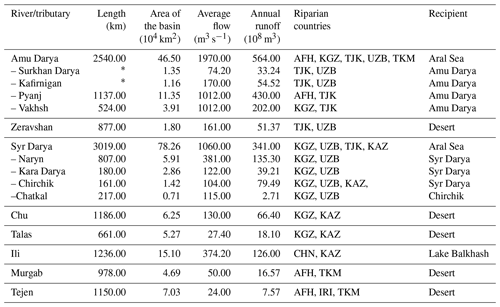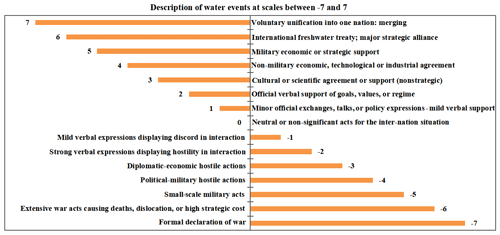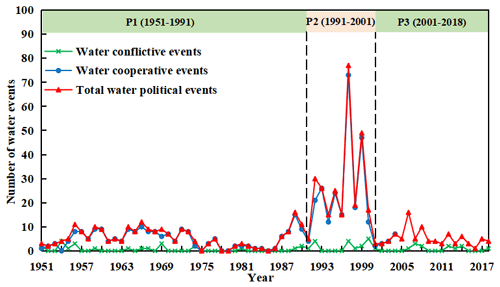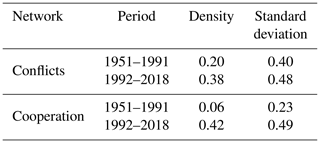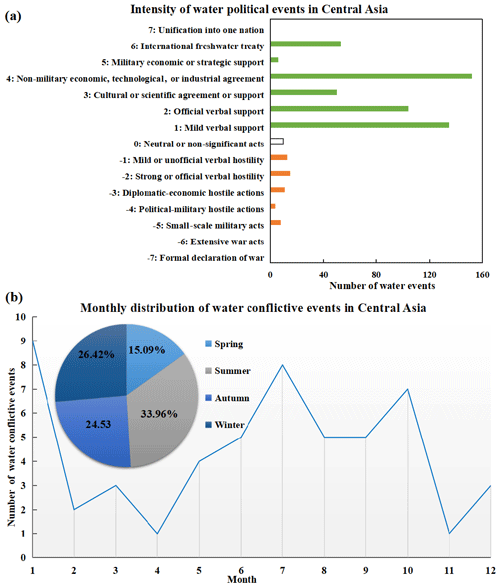the Creative Commons Attribution 4.0 License.
the Creative Commons Attribution 4.0 License.
Water resources management and dynamic changes in water politics in the transboundary river basins of Central Asia
Xuanxuan Wang
Yaning Chen
Zhi Li
Gonghuan Fang
Fei Wang
Haichao Hao
The growing water crisis in Central Asia (CA) and the complex water politics over the region's transboundary rivers have attracted considerable attention; however, they are yet to be studied in depth. Here, we used the Gini coefficient, water political events, and social network analysis to assess the matching degree between water and socio-economic elements and analyze the dynamics of water politics in the transboundary river basins of CA. Results indicate that the mismatch between water and land resources is a precondition for conflict, with the average Gini coefficient between water and population, gross domestic product (GDP), and cropland measuring 0.19 (highly matched), 0.47 (relatively mismatched), and 0.61 (highly mismatched), respectively. Moreover, the Gini coefficient between water and cropland increased by 0.07 from 1997 to 2016, indicating an increasing mismatch. In general, a total of 591 water political events occurred in CA, with cooperation accounting for 89 % of all events. Water events have increased slightly over the past 70 years and shown three distinct stages, namely a stable period (1951–1991), a rapid increase and decline period (1991–2001), and a second stable period (2001–2018). Overall, water conflicts mainly occurred in summer and winter. Among the region's transboundary river basins, the Aral Sea basin experienced the strongest conflicts due to the competitive utilization of the Syr and Amu Darya rivers. Following the collapse of the former Soviet Union, the density of water conflictive and cooperative networks in CA increased by 0.18 and 0.36, respectively. Uzbekistan has the highest degree centrality in the conflictive network (6), while Kazakhstan has the highest degree centrality in the cooperative network (15), indicating that these two countries are the most interconnected with other countries. Our findings suggest that improving the water and land allocation systems and strengthening the water cooperative networks among countries will contribute to the elimination of conflicts and promotion of cooperation in CA.
- Article
(2992 KB) - Full-text XML
-
Supplement
(170 KB) - BibTeX
- EndNote
With the exponential growth in the world's population and rapid expansion of the global economy, freshwater resources have become increasingly crucial (Fischhendter et al., 2011; Hanasaki et al., 2013; McCracken and Wolf, 2019). There are 310 transboundary rivers worldwide involving 150 countries, and even though water-sharing treaties are in place, conflicts are frequent (Di Baldassarre et al., 2013; McCracken and Wolf, 2019; Wei et al., 2021). Meanwhile, global warming has exacerbated the scarcity and uneven distribution of water resources, further complicating the water-related political situation in transboundary river basins, especially in arid regions (Wolf, 1998; Takahashi et al., 2013; Zeitoun et al., 2013; Zhupankhan et al., 2017; Chen et al., 2018).
Due to the prolonged period of inappropriate management of its transboundary waters, Central Asia (CA) is currently experiencing major contradictions between water supply and demand (Libert and Lipponen, 2012; Li et al., 2020). Most of the region's surface water resources originate in the mountains of the upstream countries (Tajikistan and Kyrgyzstan), while its agricultural areas are primarily located in the downstream countries (Turkmenistan, Kazakhstan, and Uzbekistan). This spatiotemporal dislocation of water and land resources has aggravated the complexity of water allocation (Rahaman, 2012; Wang et al., 2020a). Meanwhile, following the collapse of the former Soviet Union in 1991, the original hydropower allocation systems have become invalid, and political disputes have intensified because of the rise in competitive water demands for irrigation independence in downstream countries and energy independence in upstream countries (Chatalova et al., 2017). Water resources have thus become the key to the security and stability of CA (Bernauer and Siegfried, 2012; Karthe et al., 2015; Xu, 2017). The Central Asia Human Development Report by the United Nations Development Programme (UNDP) Regional Bureau for Europe and the Commonwealth of Independent States (RBEC) also pointed out that “the benefits from efficient use of water and energy resources could generate a regional economy twice as large and well-off 10 years from now”. Moreover, researchers contend that the degree of matching between water and socioeconomic development is significant to CA's water politics. The Gini coefficient is an effective method for measuring the matching and inequality between water resources and agricultural land (Hanjra et al., 2009; Hu et al., 2016; Yu et al., 2016; Liu et al., 2018; Qin et al., 2020), the status of yield inequality (Sadras and Bongiovanni, 2004; Kisekka et al., 2017), and the irrationality of land use structures (Zheng et al., 2013; Yan et al., 2016).
The water politics of transboundary rivers are emerging as a compelling research field in social hydrology (Wolf, 2007; Cabrera et al., 2013; Soliev et al., 2015). Some scholars have made comprehensive evaluations of water politics based on a variety of models (Wolf et al., 2003; Rai et al., 2014; Wang et al., 2015). For example, Rai et al. (2017) assessed the opportunity and risk of water-related cooperation in three major transboundary river basins in South Asia based on the fuzzy comprehensive evaluation model. Other scholars have analyzed water politics from a historical–political perspective (Mollinga, 2001; Wegerich, 2008; Link et al., 2016). In addition, water conflictive and cooperative events are key variables for characterizing the overall state of water politics in a region. The Transboundary Freshwater Dispute Database (TFDD), established by researchers at Oregon State University (Wolf, 1999), includes the water-related conflictive and cooperative events between two or more countries in transboundary river basins around the world. The TFDD has been widely used for water political analysis in the past few decades (Yoffe et al., 2003; Giordano et al., 2014; Gunasekara et al., 2014; McCracken and Wolf, 2019). Based on the TFDD database, Giordano and Wolf (2002) selected three case areas – South Asia, the Middle East, and Southern Africa – to evaluate the connections between internal and external interactions over freshwater resources, and they found that water-related events and scales usually had different complexity and spatial variations due to specific historical and political conditions. Eidem et al. (2012) used the TFDD to analyze the characteristics of water politics in the Oregon and Upper Colorado Region of the western United States and found that cooperation was more common than conflict in the domestic environment. However, the TFDD database has rarely been applied in the investigation of water politics in CA, where water is critical to regional stability. Furthermore, since most of the events recorded in the TFDD occurred prior to 2008, the study of the current water political situation in CA would require additional data sources.
At present, related research in CA mainly focuses on the management and allocation of water resources, either sub-regionally or across the entire region (Schlueter et al., 2013; Mazhikeyev et al., 2015; Chen et al., 2017). Sorg et al. (2014) analyzed the impact of climate change and socio-political development on water distribution in the Syr River basin, and they suggested that reservoirs could partially replace glaciers as water redistributors in the future. Pak et al. (2013) investigated the history of water allocation mechanisms and agreements on water sharing in the Isfara basin and highlighted that the implementation of water-sharing agreements was hindered by limited technical capabilities. Considering Uzbekistan as a case study, Abdullaev and Rakhmatullaev (2013) analyzed the transformation of water resource management in CA and concluded that the hydraulic mission has been transformed into different types of control over water management. More recently, Chang et al. (2018) explored the political risks of Central Asian countries based on the political risk assessment model and discovered that there were emergent opportunities, as well as political risks, in the region.
However, there is a lack of comprehensive research on changes in the water politics of CA from the perspective of water-related political events in conjunction with the situation of water and socio-economic development. Therefore, in this work, we evaluate the matching degree between water resources and socio-economic elements in CA. In so doing, we reveal the changing policies and institutional structures of water management, and then further explore the dynamics of water politics in CA's transboundary river basins through social network analysis. Our research informs the scientific management of water resources by policymakers and provides suggestions for more effective cooperation between Central Asian countries that can eventually be applied internationally.
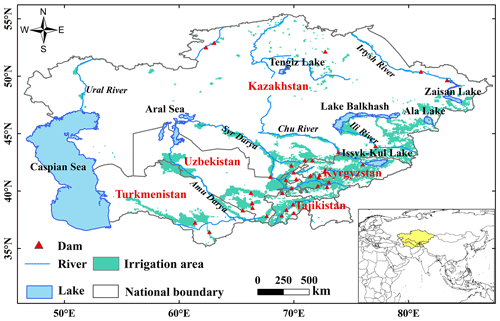
Figure 1Location of Central Asia. This map is made with ArcGIS, and all layers are from the public layers. The world and country borders are from the National Platform for Common Geospatial Information Services (https://www.tianditu.gov.cn/, last access: 4 December 2020; GS(2016)2948), the lake outlines are from the Natural Earth Data (http://www.naturalearthdata.com/, last access: 4 December 2020), and the raster file of irrigation area is from the Food and Agriculture Organization of the United Nations (http://www.fao.org/aquastat/en/geospatial-information/global-maps-irrigated-areas, last access: 4 December 2020).
2.1 Study area and its transboundary rivers
Central Asia is located in the center of Eurasia and covers a total area of 400.17×104 km2 (Fig. 1). The CA region borders Russia to the west and north, China to the east, and Afghanistan and Iran to the south (Wang et al., 2020a). There are many transboundary inland rivers in CA that originate in the upper Pamir and Tian Shan mountains (Table 1), and mainly supplied by snowmelt, glaciers, and precipitation. The Amu Darya River, with the largest annual runoff in CA (564.00×108 m3), is sourced from the Pamir plateau and crosses Afghanistan, Tajikistan, Kyrgyzstan, Turkmenistan, and Uzbekistan, where it enters the Aral Sea. The Syr Darya River is the longest in CA, with a length of 3019.00 km. It originates in the Tian Shan Mountains and passes through Kyrgyzstan, Uzbekistan, Tajikistan, and Kazakhstan before emptying into the Aral Sea (Olli, 2014).
2.2 Data
Hydrological data on the transboundary rivers of CA are obtained from the United Nations Economic Commission for Europe (http://www.unece.org/env/water/, last access: 4 December 2020). Data on water consumption and water volume in Central Asian reservoirs are obtained from the United Nations Statistics Division (https://unstats.un.org/unsd/envstats/qindicators.cshtml, last access: 4 December 2020), the Food and Agriculture Organization of the United Nations (http://www.fao.org/nr/water/aquastat/data/query/index, last access: 4 December 2020), the United Nations Data Retrieval System (http://data.un.org/, last access: 4 December 2020), and the Portal of Knowledge for Water and Environmental Issues in Central Asia (http://www.cawater-info.net/, last access: 4 December 2020). The population, gross domestic product (GDP), and cropland area data for the five Central Asian countries are obtained from the World Bank (https://data.worldbank.org/country, last access: 4 December 2020). Relevant data on water political events in CA from 1951 to 2008 are obtained from the Transboundary Freshwater Dispute Database (https://transboundarywaters.science.oregonstate.edu/, last access: 4 December 2020). The TFDD records a total of 6790 events and divides them into 15 risk scales, distributed between −7 and 7. Positive values represent cooperation, negative values represent conflict, and zero signifies neutrality. The TFDD database also records the themes of the water-related events (Yoffe et al., 2004; Eidem et al., 2012). The intensity and classification criteria of these events are shown in Fig. 2.
Since the TFDD database only documents events of water conflict and cooperation during the 1951–2008 period, for the 2009–2018 period, we used water conflictive events from the Water Conflict Chronology (WCC) database and water cooperative events from the Interstate Commission for Water Coordination of Central Asia (ICWCCA) database. The WCC is a detailed interactive online database that contains global conflicts over freshwater resources (https://www.worldwater.org/water-conflict/, last access: 4 December 2020; Gleick and Heberger, 2014). The WCC data can be retrieved and filtered according to time, location, and subject, and the data on water conflict in CA cover the period during 1990–2018. To verify the consistency of conflictive events between TFDD and WCC, we compared the conflictive events registered in the two databases for their common time span (1990–2008). The events concurred with each other (Fig. S1a in the Supplement), confirming that the conflictive events obtained by combining the TFDD and WCC databases were reliable.
The ICWCCA is a joint committee established and authorized by the heads of the five Central Asian countries (http://www.icwc-aral.uz/, last access: 4 December 2020), which is responsible for making binding decisions on issues related to water distribution and utilization in the transboundary river basins of CA (Rahaman, 2012). It contains comprehensive records of water cooperative events, such as conferences and agreements on transboundary rivers in CA, from 2000 onwards. The TFDD and ICWCCA data sets indicated similar trends of water cooperative events during the 2000–2008 period, the common time span of the two data sets (Fig. S1b), confirming that the cooperative events obtained by merging the TFDD and ICWCCA databases were also reliable. The level of the complementary conflictive and cooperative events from the complementary databases (WCC and ICWCCA) was classified according to the criteria used for the classification of water political events in TFDD (Fig. 2).
2.3 Methods
2.3.1 Gini coefficient
The Gini coefficient is an economic index proposed by the Italian economist Corrado Gini to quantify the inequality of income distribution (Shlomo, 1979). The distribution of water resources is uneven in the region, which directly affects the agricultural production and economic development, and it is similar to the income distribution inequality. For this reason, the Gini coefficient has been used as an effective indicator of the degree of imbalance in water resources between countries or regions (e.g., South Africa, Cole et al., 2018; India, Malakar et al., 2018; the Sanjiang Plain in China, Yan et al., 2016; the Dianchi Lake basin in China, Dai et al., 2018), and we use the Gini coefficient in this study to quantify the overall matching between water and socio-economic factors in CA.
The value of the Gini coefficient ranges between 0 and 1. The closer it is to 1, the lower the degree of matching, and the higher the likelihood of competition for water resources in the region, so the greater the possibility of water conflictive events; conversely, the closer it is to 0, the higher the degree of matching, and the lower the possibility of water conflictive events in the region. The Gini coefficient is applicable to all five Central Asian countries, and the level of impact is assumed to be the consistent. In general, a Gini coefficient value of 0.4 is an internationally recognized “warning line” for resource distribution gaps (Dai et al., 2018). The Gini coefficient can be calculated as follows:
where G represents the Gini coefficient, n represents the number of countries (in this study, n=5), xi represents the cumulative percentage of water consumption in the ith country, and yi represents the cumulative percentage of each socio-economic element, such that when i=1, (xi−1, yi−1) = (0, 0). The threshold values of the Gini coefficient are presented in Table 2. These thresholds are widely acknowledged to be effective for classifying the matching degree between water resources and socio-economic development in many regions with small samples (Yan et al., 2016; Liu et al., 2018).
2.3.2 Matching coefficient of water and land resources
As the Gini coefficient cannot reflect spatial variations between countries, we use the matching coefficient of water and land resources to represent the individual matching degree of the five countries. The matching coefficient of water and land resources reflects the quantitative relationship between available water resources and cropland. The larger the value of the coefficient, the better the matching degree between water and cultivated land resources (Zhang et al., 2018). The matching coefficient in the five Central Asian countries is calculated following Eq. (2):
where Mi is the matching coefficient of water and land resources in the ith country, Qi is the amount of available water resources in the ith country, αi is the percentage of agricultural water consumption in the ith country, and Si is the arable land area in the ith country (Liu et al., 2018).
2.3.3 Social network analysis
Social network analysis (SNA) is an effective method for describing the morphology, characteristics, and structure of a network (Yuan et al., 2018). It employs graph theory and algebraic models to express various relational patterns and analyze the impact of these patterns on the members of a network and the entire network. The SNA method has been widely applied in sociology, geography, information science, and other areas (Hoppe and Reinelt, 2010; Tsekeris and Geroliminis, 2013). Here, we use SNA, in combination with the common metrics of network density and degree centrality, to identify the characteristics of water-related conflictive and cooperative networks in CA. The network comprises all the countries that are involved in water political events over CA's transboundary rivers. In addition to the five Central Asian countries, the network includes any other country that cooperates or clashes with Central Asian countries over water resources.
The network density quantifies the degree of connection between each node. Its value ranges between 0 and 1, and the higher the number of contacts, the higher the network density value. The network density is calculated following Eq. (3):
where D is the network density, k is the number of nodes (here, the number of countries), and d(ni,nj) represents the relational quantity between nodes ni and nj.
The degree centrality of a node measures how central this node is to the network; the higher the degree centrality of a node, the stronger its direct interconnection with other nodes, and the more significant (central) its position within the network. The degree centrality is calculated following Eq. (4):
where CD(ni) denotes the degree centrality of node ni, n represents the number of nodes, and Xji represents the connection between nodes ni and nj. If a connection exists between the two nodes, Xji=1; otherwise, Xji=0 (Jin et al., 2010).
3.1 Matching degree between water resources and socio-economic elements in CA
3.1.1 Changing trends in the inflow and outflow of large storage facilities
Large reservoirs and dams occupy a key position in the water infrastructure management of CA and are vital to the economies of all five countries. More than 290 reservoirs with a total storage capacity of 163.19 km3 exist in CA. The water contained in reservoirs is the primary freshwater resource in the region's transboundary river basins, and the changing trends in the inflow and outflow of large reservoirs reflect the dynamics and utilization of available water resources in CA. Humans play a leading role in the operational regulation and control of these reservoirs, and there is a competitive water use between power generation in upstream countries and agricultural irrigation in downstream countries. Therefore, the allocation of the water resources in reservoirs is a key factor influencing water conflicts and cooperation in the transboundary river basins of CA.
In the Syr Darya River basin, the five most significant reservoirs are the Toktogul, Andijan, Charvak, Karakum, and Shardarya reservoirs. Of these, the Toktogul, Andijan, and Charvak reservoirs are located in the upstream region, whereas the other two are situated downstream. The Toktogul reservoir is the largest reservoir in the Aral Sea basin, with average recorded inflow and release rates of 14.16 and 13.24 km3 per annum, respectively, during the 2010–2017 period (Fig. 3), and the flow of the Naryn River is controlled by it. The amount of water released from the Toktogul reservoir has remained relatively stable over the years, but the inflow first decreased and then increased from 2010 to 2017. The Andijan reservoir is located on the Kara Darya River, in the upper reaches of the Fergana Valley (an agricultural area of regional importance). From 2010 to 2017, the Andijan reservoir received an average inflow of 4.82 km3 per annum, primarily from alpine rivers. The average outflow recorded was 5.34 km3 per annum, and most of the released water was used for crop irrigation in the Fergana Valley. The average inflow and outflow of the Charvak reservoir was 7.53 and 7.11 km3 per annum, respectively; both increased from 2010 to 2017. The water storage in the Karakum and Shardarya reservoirs, in the lower reaches of the Syr Darya River, is greatly impacted by upstream reservoirs. The average inflow of the Karakum reservoir was 20.89 km3 per annum, and the outflow was 20.33 km3 per annum. And the Shardarya reservoir had an average inflow of 19.03 km3 per annum and outflow of 18.75 km3 per annum.
In the Amu Darya River basin, the Nurek and Tuyuan reservoirs provide the main water storage facilities and are located in the upper and middle reaches of the basin, respectively. The Nurek reservoir (completed in 1979), on the Vakhsh river, is the second-largest reservoir in the Aral Sea basin. From 2009 to 2018, the average inflow of the Nurek reservoir was 21.07 km3 per annum, and the outflow was 20.64 km3 per annum, with both the inflow and outflow of the reservoir showing an increasing trend. Similar to the Nurek reservoir, the inflow and outflow of the Tuyuan reservoir also increased during that period.
Additionally, most dams and reservoirs in CA are aging and lacking in adequate maintenance or sufficient funds to maintain normal operation. This situation, coupled with the increasing population in the floodplain downstream, significantly increases the water resource risk in the region. One outcome of this risk was the 2010 flooding in Kazakhstan, caused by the collapse of the Kyzyl-Agash Dam (Libert and Lipponen, 2012). In general, the upgrading of water and energy facilities is one of the most contentious issues for the five Central Asian states and poses significant challenges to water management in CA.
3.1.2 Spatiotemporal matching between water resources and socio-economic elements
The matching degree between water resources and socio-economic elements in CA is quite diverse. As shown in Fig. 4, during the 1997–2016 period, the matching between water resources and population was better than that between water resources and other socio-economic elements; the average Gini coefficient was 0.19, that is, below the warning line of 0.4. However, the matching degree deteriorated from “highly matched” to “relatively matched” between 1997 and 2016, with a significant increase in the Gini coefficient (surpassing the significance level of 0.05). The average Gini coefficient between water resources and GDP was 0.47 (relatively mismatched). This also increased significantly from 1997 to 2016 (p<0.05), indicating that the matching degree was reduced on the whole. Specifically, the matching degree deteriorated from “reasonably matched” to “relatively mismatched” from 1997 to 2006, then reverted back to “reasonably matched” during 2006–2016. These changes were primarily attributable to the great recession that affected Central Asian countries in the 1990s and deteriorated their socioeconomic conditions. At present, most Central Asian countries have not achieved a successful economic transformation. This condition causes immense instability across most of CA (Falkingham, 2005). The matching degree between water resources and cropland was the worst, with an average Gini coefficient of 0.61. This not only exceeded the “warning line” but placed this relationship into the “highly mismatched” category. Furthermore, the matching degree deteriorated from 1997 to 2016, with the Gini coefficient increasing from 0.56 to 0.63. This indicates that the allocation of water and land resources in CA is severely imbalanced.
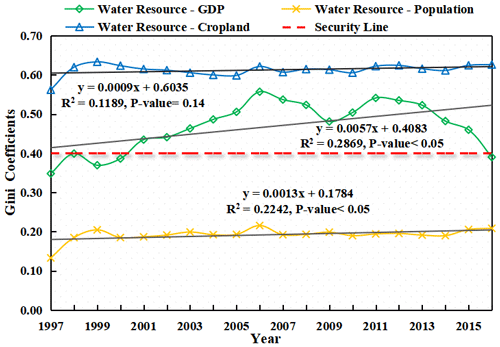
Figure 4Variations in the Gini coefficient between water resources and socio-economic elements in Central Asia from 1997 to 2016.
To further explore the matching between water and land resources, we obtained the change in the spatial matching between the available water resources and cropland in the five Central Asian countries (Fig. 5). Our findings indicate a large discrepancy in the matching coefficient of water and land resources between the upstream and downstream countries, with the matching degree being better in the former than in the latter. Tajikistan fared best, with an average matching coefficient of 2.61, followed by Kyrgyzstan (1.96). The matching coefficients of the downstream countries were 1.30 for Turkmenistan, 1.02 for Uzbekistan, and 0.29 for Kazakhstan. Compared with 1997, the matching degree between water and land resources in Turkmenistan had deteriorated significantly by 2016. However, in the same period, matching improved in the other four countries, with Kyrgyzstan exhibiting the greatest progress (an increase in the matching coefficient by 0.52).
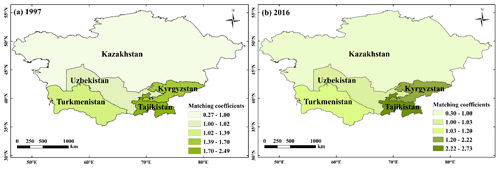
Figure 5Spatial distribution of matching coefficients of water and land resources in the five Central Asian countries in (a) 1997 and (b) 2016. The country borders are from the National Platform for Common Geospatial Information Services (https://www.tianditu.gov.cn/, last access: 4 December 2020; GS(2016)2948).
In fact, the volume of water resources in CA is relatively abundant, which equals to 3688.80 m3 per capita and is more than many regions of the world (e.g., 1148.00 m3 per capita in India, 1989.33 m3 per capita in China, and 3355.33 m3 per capita in Japan). The distribution of water resources among the Central Asian countries, however, is extremely uneven. Kazakhstan has the largest volume of water resources (643.50×108 m3), followed by the upstream countries of Tajikistan and Kyrgyzstan (634.60×108 and 489.30×108 m3, respectively), while the downstream countries, Uzbekistan and Turkmenistan, have scarce water resources (163.40×108 and 14.05×108 m3, respectively; Wang et al., 2020a). Therefore, the water contradictions in CA are not purely caused by the shortage of total water quantity. Rather, from the above analysis, the issues could be attributed to the uneven allocation of water resources and the mismatch between water and land resources among the Central Asian countries (Chen et al., 2018).
3.2 Changes in policies and the institutional structures of water management in CA
Water management policies and institutions in CA have undergone a series of changes over the past 70 years. The former Soviet Union (1922–1991) carried out large-scale land reclamation to increase agricultural production in CA, with water resources being managed by the central government in Moscow. The government established the principle of the division of labor and implemented water quotas and compensation systems for losses, with the main goal of achieving maximum economic output (Dinar, 2012). Kyrgyzstan and Tajikistan, in the mountainous upper reaches of the regional rivers, have abundant water resources and favorable terrain suitable for reservoirs and hydropower energy development. Accordingly, these two countries undertook the task of supplying water and power to Uzbekistan, Turkmenistan, and Kazakhstan in the rivers' middle and lower reaches. The downstream countries have abundant light and heat resources, favorable for large-scale irrigation agriculture. These countries provided agricultural, industrial, and energy products to Kyrgyzstan and Tajikistan (Micklin, 1988; Qadir et al., 2009). The upstream and downstream countries thus maintained a balance of interests under the joint management of the former Soviet Union.
After the collapse of the former Soviet Union in 1991, the five newly independent countries disagreed with the previous allocation of water for irrigation and power generation to a great extent (Kai et al., 2015). Therefore, the countries signed a series of treaties and established new institutions for the reallocation and management of water resources in the region's transboundary rivers. The evolution of the water management structures in CA is shown in Fig. 6. In February 1992, the Interstate Commission for Water Coordination (ICWC) was established in “agreement on cooperation in joint management, use and protection of water resources of inter-state sources”, which was responsible for determining the water releasing mechanism of reservoirs and allocation of water resources in the Amu and Syr Darya river basins. In 1993, the countries established the International Fund for Saving the Aral Sea (IFAS) to meet environmental and ecological challenges in the Aral Sea basin and realize the sustainable development of the region. In addition, the Inter-State Commission on Sustainable Development (ICSD) was established in an “agreement on joint action to address the problem of the Aral Sea and surrounding areas, environmental improvement and ensuring socio-economic development of the Aral Sea region” in 1993. The ICSD essentially managed the socio-economic activities and ecological environment of the Aral Sea basin. Then, during the reorganization of the institutions in 1997, both the ICWC and ICSD became a part of the IFAS.
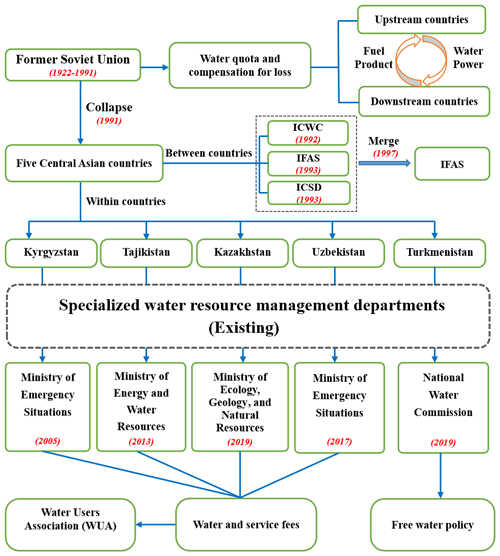
Figure 6Evolution of water management policies and institutional framework in Central Asia. Note: the numbers in red are the years in which major institutional changes occurred.
For domestic water management, each of the five Central Asian countries established specialized departments. Water resources in Kyrgyzstan have been managed by the Ministry of Emergency Situations since 2005. Tajikistan followed Kyrgyzstan's model of water resource management and established the Ministry of Energy and Water Resources in 2013. However, Tajikistan and Kyrgyzstan are the two poorest countries in CA. Owing to economic shortfalls, many water policies in these two countries are difficult to implement. Moreover, water policies in these two countries have always been linked to poverty reduction and economic benefits, so their focus differs from that of water policies in the other three Central Asian countries (Yuldashev and Sahin, 2016).
Kazakhstan assigned the authority for water management successively to the ministries of Agriculture (2002), Environmental Protection (2012), and Energy (2014). In 2019, Kazakhstan established the Ministry of Ecology, Geology, and Natural Resources to manage water. Both Uzbekistan and Turkmenistan established ministries of Agriculture and Water Resources, but the management of water resources was later segregated from that of agriculture. Specifically, Uzbekistan established the Ministry of Emergency Situations in 2017, and Turkmenistan established the National Water Commission in 2019. In terms of water fees, Turkmenistan has implemented a free water policy, while the other four countries founded the Water Users Association (WUA) to provide financial subsidies for irrigation water. Additionally, Uzbekistan has a higher capacity to implement policies for the protection of land resources and the upgrading of irrigation facilities.
3.3 Dynamics of water political events in the transboundary river basins of CA
3.3.1 Changing trends of water conflictive and cooperative events
From 1951 to 2018, a total of 591 water political events occurred in the transboundary river basins of CA, including 53 conflictive events, 528 cooperative events, and 10 neutral events (Fig. 7). The number of cooperative events accounted for 89.34 % of all water political events, which far exceeded the number of conflictive events, indicating that cooperation occurred more frequently than conflict. Over the past 70 years, the number of water political events increased slightly, with the change occurring at three main stages. From 1951 to 1991 (P1 – the former Soviet Union), water political events decreased slightly, and their range of fluctuation was stable. Then, in the first decade after the collapse of the former Soviet Union (P2 – 1991–2001), water political events increased rapidly and then declined. At first, from 1991 onwards, water events increased dramatically, reaching their highest number (77) in 1997. This was likely due to the countries being eager to explore water policies suitable for the post-Soviet era, and because of this exploration, cooperation between the countries was occasionally marred by short-term conflicts. Then, from 1997 to 2001, the number of water events declined rapidly. From 2001 to 2018 (P3), the change in water events gradually stabilized again.
3.3.2 Spatial variations in water conflictive and cooperative events
There were prominent differences in water political events across the various transboundary river basins of CA (Fig. 8). As a hydro-politically active region, the Aral Sea basin had the largest number of events (261), accounting for 44.16 % of all water political events in CA during the 1951–2018 period. The Aral Sea basin was also the site of the most water conflicts (24 conflictive events). The major water-related issues in the basin included the distribution and management of water resources in the Syr and Amu Darya rivers and the construction of large reservoirs. During the same time frame, there were 18 water political events in the Ob River basin, which is shared by Kazakhstan, Russia, and China. The main themes underlying these events were water quantity and hydropower. In the basin of the Ili River, which rises from the Khan Tengri peak on the Tian Shan Mountains, crosses China and Kazakhstan, and flows into Lake Balkhash, 13 water political events occurred, of which 12 were cooperative events. The main themes of these events were water distribution and navigation. In addition, there were 10 water political events (all cooperative) in the Tarim River basin (a transboundary river basin among China, Kyrgyzstan, etc., according to TFDD), with water quantity being the major theme. Finally, only three water political events were recorded in the Ural river basin, which flows through Russia and Kazakhstan to the Caspian Sea.
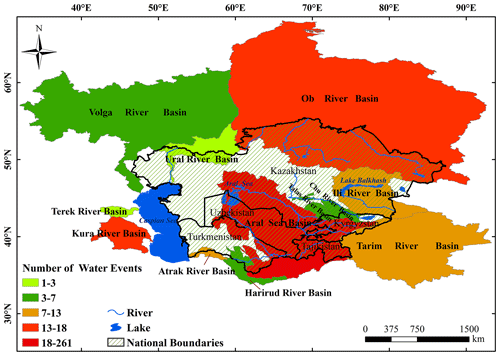
Figure 8Spatial distribution of water political events in transboundary river basins in and around Central Asia from 1951 to 2018. The country borders are from the National Platform for Common Geospatial Information Services (https://www.tianditu.gov.cn/, last access: 4 December 2020; GS(2016)2948). The borders of international river basins are from the Transboundary Freshwater Dispute Database (https://transboundarywaters.science.oregonstate.edu/, last access: 4 December 2020).
3.3.3 Network of water conflictive and cooperative events between CA and other countries
In the former Soviet Union, the water conflictive network spread across neighboring countries, with the former Soviet Union at its core. The network extended to Europe, Asia, Africa, South America, and North America (Fig. 9a) at a density of 0.20 (Table 3). The country that had the most frequent water conflicts with the former Soviet Union was Egypt (six events), followed by the United States and China (five events). However, few conflicts erupted between Kyrgyzstan, Tajikistan, and Uzbekistan within the former Soviet Union. The disintegration of the former Soviet Union had a substantial impact on the water political structure in CA, and the water conflictive network became restructured in a crisscross pattern from 1992 to 2018, with the five Central Asian countries at its core (Fig. 9b). Moreover, since 1992, the network density increased to 0.38, indicating an increase in conflictive intensity. In terms of the degree centrality (Table 4), Uzbekistan, with a centrality of 6, was at the core of the water conflictive network, followed by Kazakhstan and Tajikistan, with a degree centrality of 5 and 4, respectively. The most frequent water conflicts were between Kyrgyzstan and Uzbekistan (nine conflictive events). This is mainly because these two countries border each other and share the Syr and Amu Darya rivers, a situation that intensifies competition for water resources. Furthermore, the matches of land and water resources in the two countries are quite different, which, in itself, foments conflicts. There were seven water-related conflictive events between Kyrgyzstan and Tajikistan, six between Kazakhstan and Kyrgyzstan, and three between Tajikistan and Turkmenistan. The neighboring countries that conflicted with Central Asian countries over water primarily involved Russia, Azerbaijan, and China, with most of the conflictive events (six) occurring between Russia and CA (Kazakhstan and Russia – four; Tajikistan and Russia – two). Overall, there were three water conflictive events between Central Asian countries and China.

Figure 9Water conflictive and cooperative networks between Central Asian countries and other countries in the world. (a) Number of water conflictive events in 1951–1991 and (b) 1992–2018. (c) Number of water cooperative events in 1951–1991 and (d) 1992–2018. The world and country borders are from the National Platform for Common Geospatial Information Services (https://www.tianditu.gov.cn/, last access: 4 December 2020; GS(2016)2948).
Table 4Degree centrality of water conflictive and cooperative network for the five Central Asian countries after the collapse of the former Soviet Union (1992–2018).
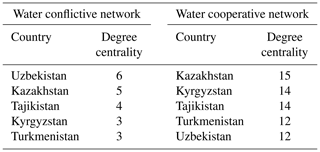
The networks of water cooperation were more complex than those of water conflict. Moreover, the scope of water cooperation in the former Soviet Union was very wide, linking 32 countries across six continents (Asia, Europe, Africa, Oceania, North America, and South America; Fig. 9c). Although these networks centered on the former Soviet Union and radiated outward, the network density was small (only 0.06). Most of the water cooperative events involving CA were linked to Egypt (41 events), followed by Iran (32 events), and China (22 events).
From 1992 to 2018, the scope of water cooperation became more concentrated (Fig. 9d). Simultaneously, the intensity of cooperation greatly increased, and the networks grew denser (density up to 0.42). Overall, Kazakhstan showed the highest degree centrality (15), indicating that it played the most prominent role in the cooperative network and engaged in the most frequent cooperation over water with other countries. Both Turkmenistan and Uzbekistan cooperated less frequently with other countries (a degree centrality of 12). Cooperation was mainly distributed among the five Central Asian countries, and water-related events between them were far more frequent than those between Central Asian and extra-regional countries. Specifically, most of the water cooperative events in CA were between Kazakhstan and Kyrgyzstan (280 events), followed by those between Kazakhstan and Tajikistan, and Kyrgyzstan and Tajikistan (260 events each). Meanwhile, CA cooperated over water with 12 countries around the world – more intensively with its western neighbors, such as Russia and Ukraine. Russia has a very significant relationship with CA for historical reasons, and it is also the key trading partner of CA (Cooley, 2009). The eastern neighboring country that CA cooperated with the most was China. Other than Turkmenistan, all of the other four Central Asian countries cooperated with China over water, with a total of 29 cooperative events.
3.3.4 Intensity and themes of water conflictive and cooperative events
Figure 10a depicts the distribution of levels in water political events, with the green bars indicating cooperative events (graded from level 1 to 7), the orange bars indicating conflictive events (graded from level −1 to −7), and the white bar indicating neutral events (level 0). Water cooperative events occurred at all levels except level 7. Most of the water cooperative events (152 events, accounting for 28.79 % of all cooperative events) occurred at level 4 (non-military agreement). These were followed by level 1 (135 events), accounting for 25.57 % of all cooperative events. Level 5 had the lowest events (6), accounting for just 1.14 % of the total. In general, low-level water cooperation was predominant in CA, with less frequent cooperation at higher levels.
Water conflictive events occurred at all levels, except levels −7 and −6. Most conflictive events (15 events, which account for 28.30 % of all conflictive events) were level −2 (strong or official verbal hostility). Level −4 conflictive events were the least frequent, accounting for only 7.55 % of all water conflictive events. These data suggest that water conflicts in CA were predominantly low level, mainly restricted to official or unofficial verbal hostility, and without any higher-level conflict. These reasonably good relations between the Central Asian countries indicate a good foundation for deeper cooperation in the future.

Figure 11Percentages of (a) water conflictive and (b) cooperative events in Central Asia according to theme.
Water political events in CA involved a variety of themes. In water conflictive events, water quantity was the most common theme, accounting for 42.00 % of all conflictive events (Fig. 11a). Due to a lack of communication and trust, the allocation of water quantity in the region's transboundary rivers was the primary cause of water conflicts in CA, especially between upstream and downstream countries. The second most dominant theme of conflictive events was infrastructure and development (26.00 % of all conflictive events), which included the construction of infrastructure and development of projects, such as reservoirs, dams, and canals. The construction of water infrastructures – especially of large reservoirs and dams (Sect. 3.1.1) – is a controversial issue in CA, since it has a direct and far-reaching effect on the availability of water in each Central Asian country. In addition, the seasonality of water conflictive events differed between the Central Asian countries (Fig. 10b); most water conflictive events occurred in January (nine events), followed by July (eight events). In general, water conflicts occurred more frequently in summer and winter (33.96 % and 26.42 % of all water conflictive events, respectively), when the water demand for irrigation and hydropower was at its highest.
Different from water conflicts, joint management was the major theme of water cooperation (Fig. 11b), accounting for 31.12 % of all cooperative events. Central Asian countries have formulated many measures for the joint management of transboundary rivers as a means for resolving disagreements and conflicts over water allocation. The theme of joint management was followed by that of infrastructure and development (17.22 % of all cooperative events) and water quantity (14.73 % of all cooperative events). Water quality, which mainly included environmental concerns, accounted for 11.62 % of all cooperative events. Flood control and/or relief (0.57 %) and economic development (0.19 %) accounted for lowest proportion of water cooperative events.
The water resources of CA's transboundary rivers underwent a unified distribution during the former Soviet Union and separate management by the five Central Asian countries after its collapse. Consequently, water politics in CA have changed dramatically. Our study indicated that the water political pattern in CA was dominated by water cooperation, with water conflictive events accounting for only 8.97 % of all water-related events. This spread is basically consistent with the overall water political trend in the global transboundary river basins. Wolf et al. (2003) found that over two-thirds of the global water political events were cooperative, while less than one-third were categorized as conflicts, and most of the latter were “mild”. However, we have further found that although water cooperation in CA had clear advantages, the level of this cooperation has been predominantly low (especially between the five Central Asian countries), indicating that the achievements of cooperation in CA are not obvious. Furthermore, the impacts of climate change, population growth, and the degradation of water and land resources have worsened the matching between water and socioeconomic development, thus intensifying the competition over water resources between the Central Asian countries.
In terms of water management policies, although the Central Asian countries have experienced reform and innovation, the current mechanisms still have some drawbacks. The first of these is that the five countries have separately allocated the management of their water to special departments, but there was no effective connection mechanism among the countries, resulting in a low cooperative efficiency. Second, the current water policies mostly targeted surface water resources (e.g., transboundary rivers), while showing a lack of effective unified management and planning of groundwater (Fang et al., 2015, 2018). Moreover, although IFAS has been an effective organization for saving the Aral Sea, it is beset with institutional weaknesses. For instance, there has been a consistently low level of information exchange between IFAS and its subordinate organizations (ICWC and ICSD; Janusz-Pawletta, 2015), and the focus of the policies formulated by each of the IFAS member countries has been quite different.
Table 5Water-related political events in the Ili River basin between China and Central Asian countries.
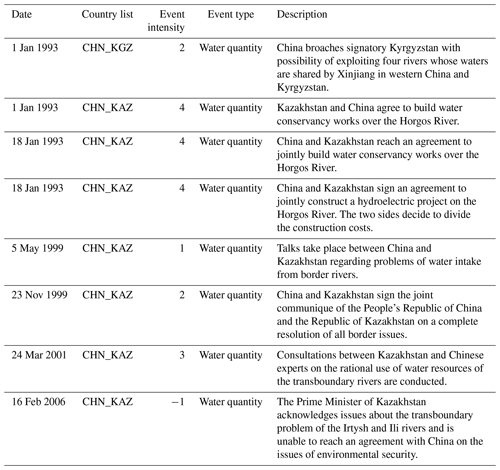
Among CA's transboundary river basins, the Aral Sea basin has faced the most serious water crisis and most complex water politics, so many studies thus far have focused on the water-related issues in the Aral Sea (Micklin, 2010; Shi et al., 2014; Zhang et al., 2019). In fact, the dramatic retreat of the lake volume and the degradation of the aquatic ecosystem have made the Aral Sea a world-renowned “ecological disaster area” (Wang et al., 2020b). According to our study, there were 24 water conflictive events in the Aral Sea basin, accounting for 45.28 % of the total conflictive events in CA. Within the basin, the Fergana Valley, located at the border of Uzbekistan, Tajikistan, and Kyrgyzstan, is particularly prone to water conflicts due to complex ethnic issues and the competition for water and arable land. For example, in 1990, an outbreak of violence over water competition in the Kyrgyzstan city of Osh, on the border of Uzbekistan, resulted in 300 casualties. Megoran (2004) indicated that the dispute in the Fergana Valley facilitated the consolidation of the authoritarian regime in Uzbekistan and also provided opportunities for anti-minority propaganda in Kyrgyzstan. In addition, there have been numerous conflicts between upstream and downstream countries over water–energy exchange in the Aral Sea basin. For instance, the Parliament of Kyrgyzstan passed a law that classified water as a commodity in June 2001 and announced that downstream countries had to be charged for water from that point onward. In response, Uzbekistan cut off all deliveries of natural gas to Kyrgyzstan. In 2012, Uzbekistan also cut off natural gas deliveries to Tajikistan in response to the construction plan of the Rogun Dam in Tajikistan, which Uzbekistan said would disrupt its water supply.
In contrast, water politics in the Ili River basin were dominated by cooperation, with water cooperative events accounting for 92 % of all water-related events. Approximately 85 % of the basin is located within Kazakhstan, with the rest 15 % being in China (Zhupankhan et al., 2017). There have been 13 water political events in the Ili River basin, eight of which were related to China (China–Kazakhstan; China–Kyrgyzstan), and seven of which were categorized as water cooperation. In fact, the overall level of cooperation has been relatively high in this region, when focusing on the allocation of water quantity in the Ili River (Table 5). Meanwhile, Duan et al. (2020) demonstrated that water flowing to Kazakhstan from the upper reaches of the Ili River in China increased from 1931 to 2013. These examples provide a positive reference for the cooperation and management of transboundary rivers in CA.
From our findings, we draw the following implications for eliminating conflicts and strengthening future cooperation in the transboundary rivers of CA. First, as both the Gini coefficient and the matching coefficient of water and land resources indicate, the matching between water and socio-economic elements (especially land resources) in CA is rather poor. This mismatch increases the potential for water conflicts, and the primary concern of water conflictive events in CA is also the competitive utilization of water resources. Therefore, improving the water and land allocation systems and strengthening the water cooperative networks between countries will help reduce water conflicts and promote transboundary river management in the region. Second, although there are more water cooperative events than conflictive events in CA, the cooperation is mainly low level, based on our findings, and verbal supports (less effective) account for a large proportion (level 1–2) in the current situation. There should be more high-level cooperation among the five countries, such as the military, economic, or strategic supports, and freshwater treaties. The successful management of transboundary rivers in CA depends on deepening the countries' cooperation and trust. In addition, CA should utilize the assistance of international and regional organizations and enhance cooperation with its neighboring countries (such as Russia and China), as these neighboring countries are CA's key trading partners and play an important role in water policy reform in the region.
In this work, we measured the matching degree between water and socio-economic elements and analyzed the dynamic changes of hydro-politics in CA's transboundary river basins. The findings are as follows.
The average Gini coefficient indicated that water resources are better matched with population than with other socio-economic elements in CA (0.19; the smallest among the measured Gini coefficient values), while this match deteriorated from “highly matched” to “relatively matched” between 1997 and 2016. The average Gini coefficient between water and GDP was 0.47, indicating a “relatively mismatched” relationship. The coefficient increased significantly during 1997–2016. The average Gini coefficient between water and cropland was the highest (0.61), indicating a “highly mismatched” relationship that deteriorated further during 1997–2016. Spatially, the matching coefficients of water and land resources in Turkmenistan (1.30), Uzbekistan (1.02), and Kazakhstan (0.29) were lower than the two upstream countries (Kyrgyzstan and Tajikistan), indicating a poor match between water and land resources in the three downstream countries, and this mismatch in Turkmenistan has continued to worsen in recent years. Therefore, the imbalanced matching of water and land resources triggered various water-related political crises in CA.
Overall, there were 591 water political events in CA, with cooperative and conflictive events accounting for 89.34 % and 8.97 % of all events, respectively. The number of water events increased slightly from 1951 to 2018, with a rapid increase followed by a decline during 1991–2001. The Aral Sea basin experienced the most water-related events (261 events) in all CA's transboundary river basins, along with the strongest conflicts (accounting for 45.28 % of all conflictive events). Conflictive events in CA mainly occurred in summer and winter, with water distribution being the major issue, while the joint management of transboundary rivers was the major issue of cooperative events.
The density of the water conflictive network in CA increased by 0.16 after the collapse of the former Soviet Union in 1991. Uzbekistan had the highest degree centrality (6) and formed the core of the conflictive network. The density of the water cooperative network increased from 0.06 to 0.42, with Kazakhstan having the highest degree centrality (15). Most conflictive events were between Kyrgyzstan and Uzbekistan (nine events), while most cooperative events were between Kazakhstan and Kyrgyzstan (280 events). Both conflict and cooperation over water were predominantly low level, with strong or official verbal hostility (level −2) and non-military agreement (level 4) having the largest proportion of water conflictive and cooperative events, respectively. We suggest that the rational management of transboundary rivers in CA could be facilitated by improving the region's water and land allocation systems, strengthening the water cooperative networks, and increasing high-level cooperation within CA and beyond.
All data used in this study can be freely obtained online. The hydrological data on the transboundary rivers of CA can be obtained from http://www.unece.org/env/water/ (last access: 4 December 2020; UNECE, 2020) and http://www.cawater-info.net/ (last access: 4 December 2020; CAWATERinfo, 2020), the water consumption data can be obtained from https://unstats.un.org/unsd/envstats/qindicators.cshtml (last access: 4 December 2020; UNSD, 2020), and the data on water political events in CA can be obtained from https://transboundarywaters.science.oregonstate.edu/ (last access: 4 December 2020; OSU, 2020).
The supplement related to this article is available online at: https://doi.org/10.5194/hess-25-3281-2021-supplement.
XW and YC contributed to the conception and design of this work. XW conducted the calculations and wrote the original draft of the paper. YC, ZL, and GF were responsible for the supervision and validation. ZL, GF, FW, and HH reviewed and edited the final draft.
The authors declare that they have no conflict of interest.
Publisher's note: Copernicus Publications remains neutral with regard to jurisdictional claims in published maps and institutional affiliations.
This article is part of the special issue “Socio-hydrology and transboundary rivers”. It is not associated with a conference.
We would like to thank the editor and the two anonymous reviewers for their valuable comments and suggestions. They significantly improved the article.
The research is supported by the Strategic Priority Research Program of the Chinese Academy of Sciences (grant no. XDA19030204), the National Natural Science Foundation of China (grant no. U1903208), and the Youth Innovation Promotion Association of the Chinese Academy of Sciences (grant no. 2018480).
This paper was edited by Jing Wei and reviewed by two anonymous referees.
Abdullaev, I. and Rakhmatullaev, S.: Transformation of water management in Central Asia: from State-centric, hydraulic mission to socio-political control, Environ. Earth Sci., 73, 849–861, 2013.
Bernauer, T. and Siegfried, T.: Climate change and international water conflict in Central Asia, J. Peace Res., 49, 227–239, 2012.
Cabrera, E., Pardo, M. A., Cabrera Jr., E., and Arregui, F. J.: Tap water costs and service sustainability, a close relationship, Water Resour. Manage., 27, 239–253, 2013.
CAWATERinfo: http://www.cawater-info.net/, last access: 4 December 2020.
Chang, T. Y., Deng, X. P., Zuo, J., and Yuan, J. F.: Political risks in Central Asian countries: Factors and strategies, J. Manage. Eng., 34, 04017059, https://doi.org/10.1061/(ASCE ME.1943-5479.0000588, 2018.
Chatalova, L., Djanibekov, N., Gagalyuk, T., and Valentinov, V.: The paradox of water management projects in Central Asia: An institutionalist perspective, Water, 9, 300, https://doi.org/10.3390/w9040300, 2017.
Chen, Y., Li, W., Fang, G., and Li, Z.: Review article: Hydrological modeling in glacierized catchments of central Asia – status and challenges, Hydrol. Earth Syst. Sci., 21, 669–684, https://doi.org/10.5194/hess-21-669-2017, 2017.
Chen, Y. N., Li, Z., Fang, G. H., and Li, W. H.: Large hydrological processes changes in the transboundary rivers of Central Asia, J. Geophys. Res.-Atmos., 123, 5059–5069, 2018.
Cole, M. J., Bailey, R. M., Cullis, J. D. S., and New, M. G.: Spatial inequality in water access and water use in South Africa, Water Policy, 20, 37–52, 2018.
Cooley, A.: Behind the Central Asian Curtain: The limits of Russia's resurgence, Curr. Hist., 108, 325–332, 2009.
Dai, C., Qin, X. S., Chen, Y., and Guo, H. C.: Dealing with equality and benefit for water allocation in a lake watershed: A Gini-coefficient based stochastic optimization approach, J. Hydrol., 561, 322–334, 2018.
Di Baldassarre, G., Viglione, A., Carr, G., Kuil, L., Salinas, J. L., and Blöschl, G.: Socio-hydrology: conceptualising human-flood interactions, Hydrol. Earth Syst. Sci., 17, 3295–3303, https://doi.org/10.5194/hess-17-3295-2013, 2013.
Dinar, S.: The geographical dimensions of hydro-politics: International freshwater in the Middle East, North Africa, and Central Asia, Euras. Geogr. Econ., 53, 115–142, 2012.
Duan, W. L., Zou, S., Chen, Y. N., Nover, D., and Wang, Y.: Sustainable water management for cross-border resources: The Balkhash Lake Basin of Central Asia, 1931–2015, J. Clean Prod., 263, 121614, https://doi.org/10.1016/j.jclepro.2020.121614, 2020.
Eidem, N. T., Fesler, K. J., and Wolf, A. T.: Intranational cooperation and conflict over freshwater: Examples from the Western United States, Univ. Council Water Resour., 147, 63–71, 2012.
Falkingham, J.: The end of the rollercoaster? Growth, inequality and poverty in Central Asia and the Caucasus, Soc. Policy Adm., 39, 340–360, 2005.
Fang, G. H., Yang, J., Chen, Y. N., and Zammit, C.: Comparing bias correction methods in downscaling meteorological variables for a hydrologic impact study in an arid area in China, Hydrol. Earth Syst. Sci., 19, 2547–2559, https://doi.org/10.5194/hess-19-2547-2015, 2015.
Fang, G. H., Chen, Y. N., and Li, Z.: Variation in agricultural water demand and its attributions in the arid Tarim River Basin, J. Agric. Sci., 156, 301–311, 2018.
Fischhendter, R., Dinar, S., and Katz, D.: The Politics of unilateral environmentalism: Cooperation and conflict over water management along the Israeli-Palestinian Border, Global Environ. Polit., 11, 36–61, 2011.
Giordano, M. and Wolf, G. A.: The geography of water conflict and cooperation: Internal pressures and international manifestations, Geogr. J., 168, 293–312, 2002.
Giordano, M., Drieschova, A., Duncan, J. A., Sayama, Y., De Stefano, L., and Wolf, A. T.: A review of the evolution and state of transboundary freshwater treaties, Int. Environ. Agreem.-Polit. Law Econom., 14, 245–264, 2014.
Gleick, P. H. and Heberger, M.: Water and conflict, in: The world's water, January 2014, Island Press, Washington, DC, 159–171 2014.
Gunasekara, N. K., Kazama, S., Yamazaki, D., and Oki, T.: Water conflict risk due to water resource availability and unequal distribution, Water Resour. Manage., 28, 169–184, 2014.
Hanasaki, N., Fujimori, S., Yamamoto, T., Yoshikawa, S., Masaki, Y., Hijioka, Y., Kainuma, M., Kanamori, Y., Masui, T., Takahashi, K., and Kanae, S.: A global water scarcity assessment under Shared Socio-economic Pathways – Part 2: Water availability and scarcity, Hydrol. Earth Syst. Sci., 17, 2393–2413, https://doi.org/10.5194/hess-17-2393-2013, 2013.
Hanjra, M. A., Ferede, T., and Gutta, D. G.: Pathways to breaking the poverty trap in Ethiopia: Investments in agricultural water, education, and markets, Agr. Water Manage., 96, 1596–1604, 2009.
Hoppe, B. and Reinelt, C.: Social network analysis and the evaluation of leadership networks, 2009, Leadersh. Q., 21, 600–619, 2010.
Hu, Z. N., Wei, C. T., Yao, L. M., Li, L., and Li, C. Z.: A multi-objective optimization model with conditional value-at-risk constraints for water allocation equality, J. Hydrol., 542, 330–342, 2016.
Janusz-Pawletta, B.: Current legal challenges to institutional governance of transboundary water resources in Central Asia and joint management arrangements, Environ. Earth Sci., 73, 887–896, 2015.
Jin, F. J., Wang, C. J., Li, X. W., and Wang, J. E.: China's regional transport dominance: Density, proximity, and accessibility, J. Geogr. Sci., 20, 295–309, 2010.
Kai, W., Rooijen, D. V., Soliev, I., and Mukhamedova, N.: Water Security in the Syr Darya Basin, Water, 7, 4657–4684, 2015.
Karthe, D., Chalov, S., and Borchardt, D.: Water resources and their management in Central Asia in the early twenty first century: status, challenges and future prospects, Environ. Earth Sci., 73, 487–499, 2015.
Kisekka, I., Schlegel, A., Ma, L., Gowda, P. H., and Prasad, P. V. V.: Optimizing preplant irrigation for maize under limited water in the High Plains, Agr. Water Manage., 187, 154–163, 2017.
Li, Z., Fang, G. H., Chen, Y. N., Duan, W. L., and Mukanov, Y.: Agricultural water demands in Central Asia under 1.5∘ and 2.0∘ global warming, Agr. Water Manage., 231, 106020, https://doi.org/10.1016/j.agwat.2020.106020, 2020.
Libert, B. O. and Lipponen, A.: Challenges and opportunities for transboundary water cooperation in Central Asia: findings from UNECE's Regional Assessment and Project Work, Int. J. Water Resour. Dev., 28, 565–576, 2012.
Link, P. M., Scheffran, J., and Ide, T.: Conflict and cooperation in the water-security nexus: a global comparative analysis of river basins under climate change, Wiley Interdisciplin. Rev.-Water, 3, 495–515, 2016.
Liu, D., Liu, C. L., Fu, Q., Li, M., Faiz, M. A., Khan, M. I., Li, T. X., and Cui, S.: Construction and application of a refined index for measuring the regional matching characteristics between water and land resources, Ecol. Indic., 91, 203–211, 2018.
Malakar, K., Mishra, T., and Patwardhan, A.: Inequality in water supply in India: an assessment using the Gini and Theil indices, Environ. Dev. Sustain., 20, 841–864, 2018.
Mazhikeyev, A., Edwards, T. H., and Rizov, M.: Openness and isolation: The trade performance of the former Soviet Central Asian countries, Int. Bus. Rev., 24, 935–947, 2015.
McCracken, M. and Wolf, A. T.: Updating the register of international river basins of the world, Int. J. Water Resour. Dev., 35, 732–777, 2019.
Megoran, N.: The critical geopolitics of the Uzbekistan-Kyrgyzstan Ferghana Valley boundary dispute, 1999–2000, Polit. Geogr., 23, 731–764, 2004.
Micklin, P.: Desiccation of the Aral Sea: A water management disaster in the Soviet Union, Science, 241, 1170–1176, 1988.
Micklin, P.: The past, present, and future Aral Sea, Lakes Reserv. Res. Manage., 15, 193–213, 2010.
Mollinga, P. P.: Water and politics: levels, rational choice and South Indian canal irrigation, Futures, 33, 733–752, 2001.
Olli, V.: Curb vast water use in central Asia, Nature, 514, 27–29, 2014.
OSU: Program in Water Conflict Management and Transformation, available at: https://transboundarywaters.science.oregonstate.edu/, last access: 4 December 2020.
Pak, M., Wegerich, K., and Kazbekov, J.: Re-examining conflict and cooperation in Central Asia: a case study from the Isfara River, Ferghana Valley, Int. J. Water Resour. Dev., 30, 230–245, 2013.
Qadir, M., D Noble, A., Qureshi A. S., and Gupta, R. K.: Salt-induced land and water degradation in the Aral Sea basin: A challenge to sustainable agriculture in Central Asia, Nat. Resour. Forum, 33, 134–149, 2009.
Qin, J. N., Fu, X., and Peng, S. M.: Asymmetric benefit compensation model for resolving transboundary water management conflicts, Water Resour. Manage., 34, 3625–3647, 2020.
Rahaman, M. M.: Principles of transboundary water resources management and water-related agreements in Central Asia: An analysis, Int. J. Water Resour. Dev., 28, 475–491, 2012.
Rai, S. P., Sharma, N., and Lohani, A. K.: Risk assessment for transboundary rivers using fuzzy synthetic evaluation technique, J. Hydrol., 519, 1551–1559, 2014.
Rai, S. P., Young, W., and Sharma, N.: Risk and opportunity assessment for water cooperation in transboundary river basins in South Asia, Water Resour. Manage., 31, 1–19, 2017.
Sadras, V. and Bongiovanni, R.: Use of Lorenz curves and Gini coefficients to assess yield inequality within paddocks, Field Crop. Res., 90, 303–310, 2004.
Schlueter, M., Khasankhanova, G., Talskikh, V., Taryannikova, R., Agaltseva, N., Joldasova, I., Ibragimov, R., and Abdullaev, U.: Enhancing resilience to water flow uncertainty by integrating environmental flows into water management in the Amudarya River, Central Asia, Global Planet. Change, 110, 114–129, 2013.
Shi, W., Wang, M. H., and Guo, W.: Long-term hydrological changes of the Aral Sea observed by satellites, J. Geophys. Res.-Oceans, 119, 3313–3326, 2014.
Shlomo, Y.: Relative deprivation and the Gini coefficient, Q. J. Econ., 93, 321–324, 1979.
Soliev, I., Wegerich, K., and Kazbekov, J.: The costs of benefit sharing: Historical and institutional analysis of shared water development in the Ferghana Valley, the Syr Darya Basin, Water, 7, 2728–2752, 2015.
Sorg, A., Mosello, B., Shalpykova, G., Allan, A., and Clarvis, M. H.: Coping with changing water resources: the case of the Syr Darya river basin in Central Asia, Environ. Sci. Policy, 43, 68–77, 2014.
Tsekeris, T. and Geroliminis, N.: City size, network structure and traffic congestion, J. Urban Econ., 76, 1–14, 2013.
UNECE: The Water Convention and the Protocol on Water and Health, available at: http://www.unece.org/env/water/, last access: 4 December 2020.
UNSD: UNSD Environmental Indicators, available at: https://unstats.un.org/unsd/envstats/qindicators.cshtml, last access: 4 December 2020.
Wang, X. J., Yang, H., Shi, M. J., Zhou, D. Y., and Zhang, Z. Y.: Managing stakeholders' conflicts for water reallocation from agriculture to industry in the Heihe River Basin in Northwest China, Sci. Total Environ., 505, 823–832, 2015.
Wang, X. X., Chen, Y. N., Li, Z., Fang, G. H., and Wang, Y.: Development and utilization of water resources and assessment of water security in Central Asia, Agr. Water Manage., 240, 106297, https://doi.org/10.1016/j.agwat.2020.106297, 2020a.
Wang, X. X., Chen, Y. N., Li, Z., Fang, G, H., Wang, F., and Liu, H. J.: The impact of climate change and human activities on the Aral Sea Basin over the past 50 years, Atmos. Res., 245, 105125, https://doi.org/10.1016/j.atmosres.2020.105125, 2020b.
Wegerich, K.: Hydro-hegemony in the Amu Darya Basin, Water Policy, 10, 71–88, 2008.
Wei, J., Wei, Y., Tian, F., Nott, N., de Witt, C., Guo, L., and Lu, Y.: News media coverage of conflict and cooperation dynamics of water events in the Lancang–Mekong River basin, Hydrol. Earth Syst. Sci., 25, 1603–1615, https://doi.org/10.5194/hess-25-1603-2021, 2021.
Wolf, A. T.: Conflict and cooperation along international waterways, Water Policy, 1, 251–265, 1998.
Wolf, A. T.: The Transboundary Freshwater Dispute Database project, Water Int., 24, 160–163, 1999.
Wolf, A. T.: Shared waters: Conflict and cooperation, Annu. Rev. Environ. Resour., 32, 269–279, 2007.
Wolf, A. T., Yoffe, S. B., and Giordano, M.: International waters: Identifying basins at risk, Water Policy, 5, 29–60, 2003.
Xu, H. Y.: The study on eco-environmental issue of Aral Sea from the perspective of sustainable development of Silk Road Economic Belt, Conf. Ser. Earth Environ. Sci., 57, 012060, https://doi.org/10.1088/1755-1315/57/1/012060, 2017.
Yan, F. Q., Zhang, S. W., Liu, X. T., Chen, D., Chen, J., Bu, K., Yang, J. C., and Chang, L. P.: The effects of spatiotemporal changes in land degradation on ecosystem services values in Sanjiang Plain, China, Remote Sens., 8, 917, https://doi.org/10.3390/rs8110917, 2016.
Yoffe, S., Wolf, A. T., and Giordano, M.: Conflict and cooperation over international freshwater resources: Indicators of basins at risk, J. Am. Water Resour. Assoc., 39, 1109–1126, 2003.
Yoffe, S., Fiske, G., Giordano, M., Larson, K., Stahl, K., and Wolf, A. T.: Geography of international water conflict and cooperation: Data sets and applications, Water Resour. Res., 40, W05S04, https://doi.org/10.1029/2003WR002530, 2004.
Yu, S., He, Li., and Lu, H. W.: An environmental fairness based optimisation model for the decision-support of joint control over the water quantity and quality of a river basin, J. Hydrol., 535, 366–376, 2016.
Yuan, J. F., Chen, K. W., Li, W., Ji, C., Wang, Z. R., and Skibniewski, M. J.: Social Network Analysis for social risks of construction projects in high-density urban areas in China, J. Clean Prod., 198, 940–961, 2018.
Yuldashev, F. and Sahin, B.: The political economy of mineral resource use: The case of Kyrgyzstan, Resour. Policy, 49, 266–272, 2016.
Zeitoun, M., Goulden, M., and Tickner, D.: Current and future challenges facing transboundary river basin management, Wiley Interdisciplin. Rev.-Clim. Change, 4, 331–349, 2013.
Zhang, J. Y., Chen, Y. N., and Li, Z.: Assessment of efficiency and potentiality of agricultural resources in Central Asia, J. Geogr. Sci., 28, 1329–1340, 2018.
Zhang, J. Y., Chen, Y. N., Li, Z., Song, J. X., and Zhang, Q. F.: Study on the utilization efficiency of land and water resources in the Aral Sea Basin, Central Asia, Sust. Cities Soc., 51, 101693, https://doi.org/10.1016/j.scs.2019.101693, 2019.
Zheng, X. Q., Xia, T., Yang, X., Yuan, T., and Hu, Y. C.: The Land Gini Coefficient and its application for land use structure analysis in China, PLoS One, 8, e76165, https://doi.org/10.1371/journal.pone.0076165, 2013.
Zhupankhan, A., Tussupova, K., and Berndtsson, R.: Could changing power relationships lead to better water sharing in Central Asia?, Water, 9, 139, https://doi.org/10.3390/w9020139, 2017.






